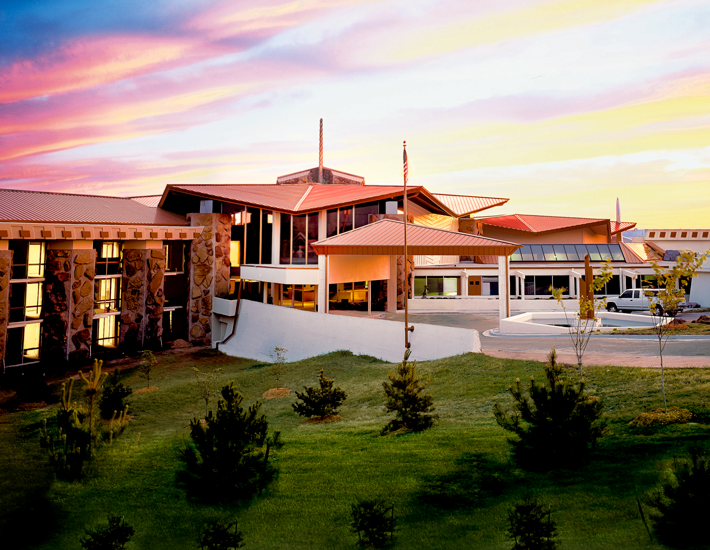
Narconon Arrowhead
Drug Rehab Center Oklahoma

Drug Rehabilitation, Education, and International Training Center
Narconon Arrowhead is Narconon’s leading drug rehabilitation center and has been helping people overcome their addiction for nearly three decades. Thousands of individuals have been assisted in overcoming their addiction at this center, enabling them to live productive, drug-free lives.
The facility is located on beautiful Lake Eufaula in southeastern Oklahoma. It is a peaceful, spacious setting that enhances the rehabilitation process. Here, in this distraction-free setting individuals receive the one-on-one care and personalized attention that is often necessary to accomplish our goal of long-term success.
The Narconon program takes a comprehensive approach to handling addiction addressing both the physical and mental aspects of drug abuse. The program begins with a drug-free withdrawal and a unique sauna detoxification regimen to repair the physical damage caused by drugs, followed by a series of life skills training which enables you to repair and rebuild your life.
Learn more about the Narconon Arrowhead facility
Lives Saved from Addiction
The following are testimonials from a number of individuals who experienced the life-saving drug rehabilitation program at Narconon Arrowhead:
- Gena: "I feel like I have accumulated a lot of skills that I can go out there and use in life."
- Lou: "Narconon has given me a new life. My family loves me and I love my family."
- Wayne: "I have my life back. My family has their son back."
- Amanda: "I can use the tools that were given to me and not go back and use again."
- Brian: "I feel awesome. I feel on top of the world!"
- David: "I can have a happy, productive life—for the first time in my life."
- Hayes: "I have myself back. I have my dignity and respect."
- Rick: "I’ve had the best communication with my parents and my wife and my kids."
- Robert: "I’m ready to take on the whole world."
- Susan: "Narconon is where you want to have your child. It is a place where they can be safe."
Mechanics of Addiction Part I
by Gary Smith, Narconon Arrowhead

What is Addiction, Really?
Whether a person is genetically or biochemically predisposed to addiction or alcoholism is a controversy that has been debated for years within the scientific, medical and chemical dependency communities. One school of thought advocates the “disease concept,” which embraces the notion that addiction is an inherited disease, and that the individual is permanently ill at a genetic level, even for those experiencing long periods of sobriety.
Another philosophy argues that addiction is a dual problem consisting of a physical and mental dependency on chemicals, compounded by a pre-existing mental disorder (i.e., clinical depression, bipolar disorder, or some other mental illness) and that the mental disorder needs to be treated first as the primary cause of the addiction.
A third philosophy subscribes to the idea that chemical dependency leads to permanent “chemical imbalances” in the neurological system that must be treated with psychotropic medications after the person has withdrawn from their drug of choice.
The fact remains that there is some scientific research that favors each of these addiction concepts, but none of them are absolute. Based on national averages, there is a 16% to 20% recovery rate; the message is pretty clear that these theories are just that–theories and we have a lot more to learn if we are to bring the national recovery rate to a more desirable level.
There is a fourth school of thought which has proven to be more accurate. It has to do with the life cycle of addiction. This data is universally applicable to addiction, no matter which hypothesis is used to explain the phenomenon of chemical dependency. The life cycle of addiction begins with a problem, discomfort or some form of emotional or physical pain a person is experiencing. The person finds this very difficult to deal with.
Here is an individual who, like most people in our society, is basically good. He has encountered a problem that is causing him physical or emotional pain and discomfort that he does not have an immediate answer for. Some examples would include difficulty “fitting in” as a child or teenager, puberty, physical injuries such as a broken bone, a bad back or some other chronic physical condition. Whatever the origin of the difficulty is the discomfort associated with it presents the individual with a real problem. He feels this problem is a major situation that is persisting and he can see no immediate resolution or relief from it. Most of us have experienced this in our lives to a greater or lesser degree.
Once the person takes a drug he feels relief from the discomfort, and even though the relief is only temporary it is adopted as a solution to the problem and the individual places value on the drug or drink. This assigned value is the only reason the person ever uses drugs or drinks a second, third or more times.
There is a key factor involved in this life cycle scenario that determines which one of us becomes an addict and which one does not. The answer depends on whether or not, at the time of this traumatic experience, we are subjected to pro-drug or alcohol influences via some sort of significant peer pressure that influences our decision-making process in regards to how one will find relief from the discomfort. Peer pressure can manifest itself in many different ways. It can come from friends or family members or through some venue of advertising or promotion which, when combined with the degree of relief we receive from the drug or drink, determines the severity of the use. Simply put, the bigger the problem the greater the discomfort the person is experiencing. The greater the discomfort the more importance the person places on relieving it and the greater the value he assigns to that which brought about the relief.

For those that start down the path of addiction, they will encounter other physical, mental and lifestyle changes along the way that will begin to disintegrate the individual’s quality of life. If the drug or alcohol abuse continues unchecked, eventually the person is faced with so many unpleasant circumstances in their life that each sober moment is filled with so much despair and misery that all he wants to do is escape these feelings by medicating them away. This is the downward spiral of addiction. At this point for most, there are only three imminent outcomes: death, prison or sobriety.
If you know someone in need of help, I recommend that you research all of your treatment options. Take the time to thoroughly inspect the treatment program available. Determine how these programs address the mechanics of addiction. Find out what their long-term recovery rate is. Drug rehabilitation does not have to be a revolving door if you take the time and effort to pick the right recovery program.
 ®
®